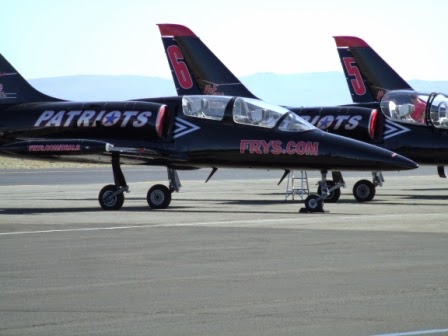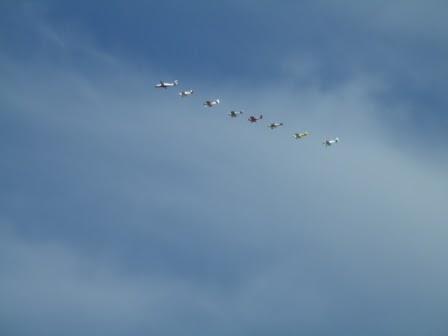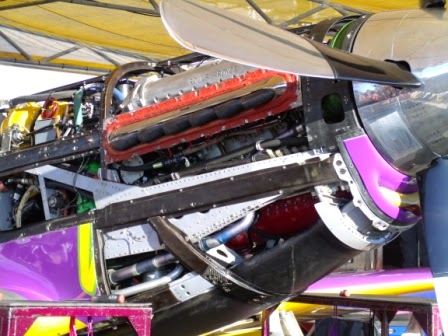Went to the 2014 Reno Air Races last
week. Caution - uber geeky .
Anyone
with even the slightest interest in aviation has heard of the Reno Air
Races. It’s the only place on earth where like-minded air jockeys can
gather and try to kill each other, without setting off an international crisis.
It is an absolutely glorious testament to aviation lunacy. I was thrilled to
witness it firsthand. I would love to have flown in it, but I am missing the
following essentials:
·
basketball
size gonads
·
1,000's
of hours of flight time
·
deep
pockets
·
give-a-shit
attitude towards death
The
Reno Air Races were started in 1964 just a few miles away from they are
currently held - Reno Stead Airport. Stead was an Air Force Base until
1966 (translation? - terrific runways). The idea is pretty simple. Be the
fastest one to fly around a bunch of pylons for 6 laps without passing out from
the G forces, flying into the surrounding hills, or smashing into a fellow
idiot doing the same stupid thing.
The
courses vary in size depending on what type of plane is being flown (the faster
planes need the biggest course)
|
This
looks rather straightforward on paper, until you look at the satellite image
and realize the course is surrounded with hills. (splat marks abound)
They fly 6 different classes of planes.
1.. Unlimited
– as long as you have a piston driven propeller – anything goes
2. T-6
(or SNJ if you’re a navy guy)
3. Biplane
– must have 2 wings (duh!) and limited to 180HP fixed pitch prop.
4. Formula
One – the most restricted class – lots of rules, the main one being engine is
limited to 100HP. Surprisingly, 300+ mph is common.
5. Sport
Class – mostly Lancair Legacy,
Glasair's and RV – but all happily trashed by a LongEZ (the only plane at the
whole show I’ve ever flown)
Glasair
LongEZ
6. Jet
– no afterburners (damnit), no wing sweep more than 15 degrees.
Mostly L39’s (the ones pictured below are actually part of the aerobatic demonstration team)
|
To start a race, everyone in the class takes
off and forms up on a race committee plane (usually a corporate jet flown hard
by a very happy pilot tired of ferrying VIPs around for a living).
You can hear on the radio the race committee
officials yelling at the planes to get into position
after which they utter
the magic words “gentlemen, we have a race”
As soon as they hear that, the pilots
throttle all the way up and it’s anything goes. On the back of the course the
altitude height limit is 400 AGL (above ground level).
This is the main pylon (finish line)
This is right in front of the grandstands.
Planes are restricted to no more than 250 feet AGL here. The thought is
that at that low of an altitude, should things go awry, the plane probably
doesn’t have enough altitude to fly all the way over to the grandstands and
kill paying spectators. In 2011 they had a horrific accident with a P51 that
killed 11 people when the plane went out of control and crashed into the
stands. What happened is that the elevator trim tab broke off, the
elevator snapped full up - sending the plane into an instantaneous 11G pull up
that knocked the pilot unconscious and sent him into the stands (one of the
guys sitting in front of me was there for the accident and said that he
actually got sprayed with fuel).
If you look at the main pylon you’ll notice
that there are two flagpoles. When the lead plane flashes past on lap 4
they hoist a white flag (meaning one lap to go before the finish lap). Radio
communication is kept to a minimum to avoid distracting the pilots (besides, at
full throttle most of them can’t hear a damn thing anyway). Years ago the
pilots all complained that they couldn’t see the flags. The race committee got
tired of hearing about it, so they hired a local stripper to stand next to the
flag wearing nothing but a micro throng. At the post-race pilots meeting, every
single pilot was able to correctly report the color of the micro thong (along
with her bra size should she have been wearing one). The race committee had
made their point and that was the end of the bitching about not being able to
see a 6’ by 6’ flag.
In order for the race to be fair, judges are
posted at each pylon to make sure no one cuts the corner.
Over the years
this day long job out in the middle of the desert has turned into a huge party
(of sorts). Most of the pylon crews have been doing duty for decades and are in
the process of handing down the traditions to the next generation. From the
local newspaper – “The
pylon crews are entreated to 10 hours of boredom interrupted occasionally by 12
minutes of mayhem. There’s a core of these folks, and the majority of them out
in the boondocks today have it down to a science. They’re famous for
their barbeques, and they host mini-parties. The kindly group at Outer-4 pylon
(Warbirds) who come down from Alaska en-masse each year will invite the group
from Middle-5 (T-6’s) for a sitting of Grumman Bearcat Stew. The Inner-5
crew (biplanes) might visit nearby Outer-7 for their famous Bob Hoover
Tennessee Waltz chicken. Tables are set, usually with cloth tablecloths
and decent silverware and crystal. Most pylons have generators feeding TV sets
for football games. Unnerving to many race pilots as they passed low overhead
was a roughly oval 40 foot piece of Astroturf, placed on a surface lovingly
leveled by one pylon crew with a regulation golf cup and a flag pin placed in
the cup, to host the Inner-3 Invitational golf tournament attended by Outer-3
and 4, and Middle 2 and 4”.
Like most attendees, I spent hours in the
pits talking to pilots and mechanics. I was fortunate to make friends
with a guy who was here for his 30th time. He was a wealth of
information. For example:
This is Voodoo, a modified P-51 Mustang (by
the way, Voodoo won the Gold Cup on Sunday)
Voodoo started out as a P-51. Millions
of dollars later, it still looks like one until you look closely (and have
someone knowledgeable point things out). A regulation P-51 weighs around 7,600
pounds. Voodoo has been extensively rebuilt with carbon fiber and is
rumored to only weigh 5,000 pounds fully fueled. They also went to a helluva
lot of trouble to take out the 2 degree down and to the right engine mount
offset (I won’t bore you with why – mainly because I don’t fully understand it
myself) but this was a major modification to the airframe. The engine (a Merlin
WW II marvel) has been extensively re-worked to produce more horsepower without
exploding (a very common problem in years past).
The result? Voodoo is
about 100mph faster than a normal P-51. I watched it on the course doing
qualification runs. It’s so much faster than a normal P-51 that in only 5
laps it lapped the regulation P-51 that was out on the course with him
(I swear I saw the regulation 51 pilot giving him the finger as he zoomed
past). In fact, if you look at the posted lap times for the 2014 races,
Voodoo is only 2 mph slower than the jets. It screams as it goes past and never
failed to give me goose bumps. God it makes an awesome noise! This is last
year's winning flight by Steve Hinton https://www.youtube.com/watch?v=3e1f89eidFs
This is Steve (kneeling) and Bruce (my friend
from Junior HS and pastor of Carson City Presbyterian church)
My second favorite plane of the races was
this beauty – Czech Mate
Czech Mate is a stunningly beautiful modified
Yak 11. Actually saying it is “modified” is a bit of an understatement. The
original Yak 11 had 700 HP. Czech Mate is turning more than 2,500
HP. It is a handful to fly and has had some spectacular moments http://www.warbirdaeropress.com/articles/CzechMate/Smoot.htm
The guy that flies it got his pilot’s license
at age 14 and is currently a 767 captain.
But it won’t beat the modified P-51s. I
wondered why and I have a working theory. The 51’s use Merlin V12
monsters. Apparently there are ways to coax more horsepower out of them.
Not so with radial engines. The radial engines they race with were designed in
the late 30’s and the fact is that those old guys did a damn fine job of getting
all that is possible out of them. This is what they look like.
If you were to look closely at the cylinders
you would see that you can’t increase the piston size – the cylinder walls are
paper thin already. So what happens when you push them too far by increasing
fuel injection and stuffing more air in them?
Melted pistons and deformed wrist pins
Bent connecting rods
Exploded cylinders
When you build an airframe around a radial
engine you run out of options. This was taken to the extreme by the
Dreadnaught
Dreadnaught started out as a Sea Fury
They took the regular engine out and stapled
in the largest radial engine ever made – the R4360. The 4360 number means
the engine has 4,360 cubic inches (and 56 spark plugs that are easily fouled).
The one in the Dreadnaught has two superchargers and two
turbochargers.
It is simply massive (over 4,500 HP). But it
still isn’t enough. Back in the 1980s the Dreadnaught always won the
gold. This year it came in third. The best thing about the big radials is that
if you don’t push them too hard, while they’re not exactly reliable, they’re way
more reliable than the hopped up Merlins. The racing strategy is to fly the
course carefully (avoiding cutting a pylon) and wait for the Mustang in front
of you to explode.
It still strikes me as odd that the WW II
Mustangs do so well. If you think about it, they weren’t the last of the piston
powered fighters. The Hawker Sea Fury (British) and the F7F (USA) were the last
of the post war piston fighters.
The Sea Fury
Was well represented at the races. Look
closely at the number of blades on the prop (5).
The Sea Fury uses the last piston engine
produced by the Brits and is a radial 18 cylinder with a two speed supercharger
(3,000 HP). It was designed near the end of the war simply to be a pure
air superiority fighter. The jet engine, of course, trashed it. With a top
speed of 460 mph, it just isn’t faster than a Mustang on steroids.
The Grumman F7F Tigercat
is a similar technological piston engine
marvel. Top speed? Again, 460 mph. Not enough, but cool as hell
looking and sounding with its twin 2,100 HP radials. Right now it only
qualified for the Silver class of unlimited. Right after it took off for the
race it circled around and promptly landed. I talked to the chief mechanic
the next day and he was properly pissed. All that was wrong was that the
main warning light wire had chaffed through (due to vibration) and shorted to
ground. This made it come on when there was nothing wrong with the plane.
Better safe than sorry, but damn. Maydays at the races are a quite common
occurrence. At last count there were no less than 26 by Saturday. When I
said it wasn’t a safe sport, I wasn’t kidding. During qualifications earlier in
the week the wing of a sport plane disintegrated and the pilot augured in
(killing him instantly).
Another remarkable plane is “Precious Metal”.
Your eyes aren’t deceiving you.
Precious Metal has twin counter-rotating props. There may be a bright future
for Precious Metal. It is the only Mustang in the world with the Griffon
engine. The Griffon is the successor to the Merlin engine. If you look up
Griffon on Wikipedia you’ll find that there are no less than 50 variants of the
Griffon. If they can get this thing properly tuned up, it might yet be a
contender.
This email is getting too long so I’ll skip
the jets (they are fast, but kinda boring).
Finally pilot humor
GIB stands for "guy in back"
And finally one miniature oddity (actually runs)






_Bottom_Gun_2014_Reno_Air_Races_photo_D_Ramey_Logan.jpg)
.jpg)
_Jus_Pass_n_Thru_2014_Reno_Air_Races_photo_D_Ramey_Logan.jpg)










































